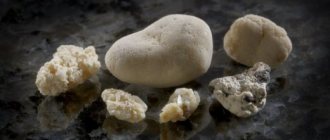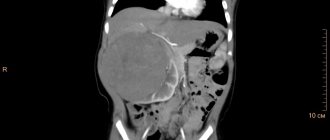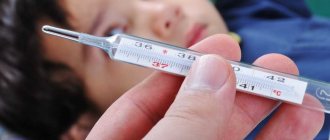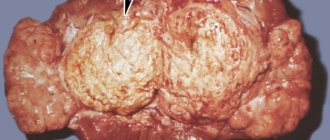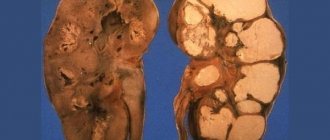Signs of cold kidneys
In addition to back pain, the patient is also bothered by a frequent urge to urinate; in some cases, however, it, on the contrary, becomes rare. The urine changes color or contains blood, causing thirst. As a rule, as a result of this disease, the patient’s eyelids, arms and legs become swollen, especially after sleep, since the kidneys cease to cope with the excretory function. And the skin is covered with a rash, which appears due to a high concentration of toxins in the blood. You can smell ammonia from the patient's mouth. Its taste also changes. In addition, there is fever, increased fatigue, and in some cases, loss of appetite, nausea, vomiting, blood pressure disorders, weight loss and even blurred vision.
What to do if you suspect a cold in your kidneys?
Kidney pain is a symptom that cannot be ignored. Therefore, be sure to consult a doctor at the first manifestations of the disease. In addition, back pain and kidney pain are often difficult to distinguish even for specialists. This requires tests and examinations. Don't be overconfident! Incorrect diagnosis and inaccurate treatment can lead to very serious consequences! First of all, you need to donate urine and blood for analysis. You may need to do an ultrasound of your kidneys. The urologist, having received all the examination data, will prescribe treatment. As a rule, antibiotics are required to cure cold kidneys. Symptoms can be deceiving, and sometimes you can get by with weak drugs. Therefore, do not take anything without the advice of a doctor.
Remedies for the condition
If you are prescribed antibiotics, then herbal teas will be an excellent support for the body. You can purchase a renal preparation at the pharmacy and take it as indicated in the instructions. It has both a diuretic and anti-inflammatory effect, while increasing the body's defenses. To check if you are allergic to this drug, for the first time take a dose reduced by 10 times. If the reaction is good, then drink in full doses, but no more! If you have cold kidneys, your symptoms suggest that a sitz bath will be very helpful. Add a decoction of the kidney collection to warm water heated to 40º and sit in it for 15 minutes. Before going to bed, you can also warm up your feet by adding sea salt or mustard to the water. In bed, place an electric heating pad under your lower back and lie on it for about an hour. Warming up must be done until complete recovery. After completing the entire course, you need to take all the tests again to make sure that you have cured your cold kidneys. Symptoms may disappear, but the inflammation remains, becoming chronic, so re-checking is extremely necessary. Be healthy!
Diseases of the urinary system can develop under the influence of various factors.
One of the common reasons for the initiation of the inflammatory process is local or general hypothermia, which can lead to serious negative consequences for health.
Let's figure out what symptoms bother a person who has a cold in the kidneys, and also find out how this condition can be treated.
Health care
If a patient suddenly gets a cold in his kidneys, only a urologist should develop a treatment plan for how to treat the kidney organs. Initially, the patient is referred for an ultrasound examination.
Only after receiving the results of ultrasound and laboratory tests can the doctor assess the extent of organ damage and identify the cause, which will allow the patient to be effectively treated in the future.
If the results of ultrasound and laboratory tests are not enough to establish the correct diagnosis, cystoscopy is performed.
The doctor will tell you what the patient should do and what medications to take if he has a cold in his kidneys for any reason. In most cases, antibiotics are prescribed to fight the inflammatory process.
In addition, taking antispasmodic drugs eliminates pain. It is important to take diuretics, which help flush out harmful substances from the kidneys.
The kidneys should be treated immediately; if this is not done, thunderonephritis or pyelonephritis occurs, which pose an even greater danger to human health.
Kidney diseases
Gromeluronephritis is accompanied by a severe inflammatory process, which is characterized by symptoms such as red swelling spreading throughout the body, and especially over the face.
Gromeluronephritis is also accompanied by cardiovascular disorders, so it is impossible to treat the patient without an ECG.
Only a doctor knows what to do if the kidneys are hypothermic. The patient must follow all his recommendations strictly to ensure complete restoration of the renal organs.
Nagging pain
Pyelonephritis and glomerulonephritis are accompanied by pain in the lumbar region. Discomfort may be felt on one or both sides. It occurs due to stretching of the renal capsule containing nerve endings by an inflamed organ or overflowing with urine.
Typically, renal pain is nagging, aching, dull, constant or paroxysmal in nature. It can intensify after exercise, when lying on your side and touching the skin in the affected area. In some cases, discomfort spreads to the lower abdomen or encircles the body.
Traditional medicine and prevention
In cases where the kidneys get cold, inaction is detrimental to health, therefore, as soon as the first symptoms of the inflammatory process in the kidneys appear, you can, with the permission of a doctor, resort to the help of traditional medicine.
Folk remedies not only allow you to fully treat colds, but also increase the effectiveness of traditional treatment.
Herbal medicine is highly effective in gently relieving inflammation and increasing kidney function. To do this, you should make daily decoctions based on bearberry, bear's ears and lingonberry leaves.
ethnoscience
Cranberry and lingonberry juices are quite effective, relieving unwanted symptoms and ensuring kidney recovery.
When the kidneys get cold, it is advisable to take a rosehip decoction, since it has an excellent diuretic effect and contains a large amount of vitamin C. You can add honey to the rosehip decoction.
It is useful to make and drink systematically tea from chamomile, St. John's wort, corn silk and horsetail, which has a beneficial effect on the body as a whole and on the kidneys in particular.
In pharmacies you can purchase ready-made herbal teas and herbal preparations that help get rid of kidney problems. These include Urolesan, Fitolysin, Canephron.
At the first sign of allergy, stop taking medicinal herbs. Resume taking medicinal teas only after consulting an allergist.
There are a number of tips that everyone can follow to improve their health and prevent inflammatory processes.
It is very important to carry out hardening procedures. When going outside, dress according to weather conditions, avoiding freezing.
If it was not possible to avoid hypothermia, and a person has caught a cold in the kidney organs, one cannot endure the pain and do nothing; it is important to immediately consult a doctor for help.
The term “kidney cold” refers to various inflammatory diseases that have similar symptoms to colds: headache, weakness, malaise, fever and chills. In addition, they often occur against the background of viral respiratory infections or some time after an illness.
In diseases associated with cold kidneys, the symptoms of a viral infection are complemented by the appearance of pain in the lumbar region, an increased urge to urinate with a sharp decrease in the amount of urine excreted per day. And also signs of a kidney cold are the presence of discomfort and a burning sensation when urinating, cloudy urine, with the presence of blood, sand or small stones in it.
Most often, the inflammatory process (inflammation of the renal pelvis, calyces and kidney parenchyma) occurs as a result of hypothermia, viruses penetrating the blood and activating pathogenic microflora - staphylococci, streptococci, Proteus or E. coli, as well as due to bacterial infection (past tonsillitis, scarlet fever, rheumatic diseases ).
Headache, weakness, malaise
The inflammatory process in the kidneys triggers a number of mechanisms that lead to an increase in temperature and a deterioration in overall health. The person experiences:
- headache;
- weakness;
- decreased appetite;
- loss of vitality;
- muscle and joint pain;
- drowsiness;
- chills;
- increased sweating;
- irritability and other unpleasant symptoms.
The listed manifestations are the result of the following processes:
- slowing down the functioning of nerve cells;
- inhibition of metabolic processes at the cellular level;
- lack of oxygen;
- intoxication (poisoning) due to the penetration of waste products of pathogenic flora into the bloodstream.
The severity of intoxication in nephrological diseases is especially high, since the kidneys do not fulfill their task - they do not filter the blood and do not remove harmful substances.
Cold: symptoms
Pathogenic bacteria cause an inflammatory process in tissues - pyelonephritis, pyelitis or glomerulonephritis. These diseases are known as kidney inflammation. The inflammatory process can be one-sided or affect both kidneys.
Acute pyelonephritis is an infectious inflammatory process that affects the renal parenchyma (the organ tissue itself), pelvis and calyces. Symptoms of cold kidneys are a sudden increase in temperature to 39-40 C, chills, heavy sweating, headache, and severe with the addition of nausea, vomiting and an increase in headache. And also signs of cold kidneys appear in the form of a deterioration in general well-being (increasing weakness and malaise), thirst, difficulty urinating (due to inflammation and swelling of the ureters) and the appearance of cloudy urine, with the presence of blood, salts and sand in it.
Most often, acute pyelonephritis occurs against the background of or after acute purulent processes (angina, endocarditis or purulent gynecological diseases) or in the presence of chronic diseases (chronic tonsillitis, adenoiditis, subacute septic endocarditis and endometritis, adnexitis).
Chronic pyelonephritis can occur as a consequence of untreated acute pyelonephritis or in the complete absence of treatment (primary chronic pyelonephritis), especially if it is acutely cold kidneys and the symptoms occurred against the background of a viral or bacterial infection, and subsequently manifested themselves only as periods of unexplained fever during exacerbation of the disease. In this case, the diagnosis of the disease often presents great difficulties and is revealed only with a full comprehensive examination of the patient.
Glomerulonephritis is a complex inflammatory process with predominant damage to the glomerular vessels. Most often, this disease occurs after tonsillitis, tonsillitis, scarlet fever or upper respiratory tract infections (pneumonia, purulent bronchitis), as well as after hypothermia in a humid environment, the so-called “trench” nephritis.
With glomerulonephritis, the symptoms of a kidney cold manifest themselves in the form of swelling on the face, against the background of pronounced pallor of the skin (nephritic face), the appearance of blood in the urine and increased blood pressure. If the kidneys have a cold, then symptoms of glomerulonephritis in young people may manifest as signs of heart failure (shortness of breath on exertion, pain in the heart), ECG abnormalities, the appearance of blood and protein in the urine.
What to do?
If there are signs of an inflammatory process, you should consult a urologist to diagnose the disease. It must be remembered that a kidney cold is not just a seasonal disease, but an inflammatory process that requires clarification of the diagnosis and thorough treatment. Therefore, if you have a cold in your kidneys, only a doctor can decide how to treat it based on laboratory and instrumental research methods.
Laboratory tests of the patient's urine and blood can indicate the presence of an inflammatory process. If a kidney cold is diagnosed at an early stage, treatment will be more effective. A urine test and bacterial cultures determine the pathogen that caused the inflammation and will facilitate the selection of the appropriate antibacterial drug; a biochemical blood test will show the functional capacity of the kidneys. And with the help of X-ray and ultrasound examinations, you can determine the condition of the kidneys and ureters, the presence or absence of an inflammatory process, stones or sand.
In dank, damp autumn weather and in winter, when the ground is frozen, it is no wonder that you get a cold not only in the throat, but also in the internal organs - for example, the kidneys. It is possible to get rid of the symptoms of acute respiratory viral infections and even the flu within a week, maximum 10 days. But curing kidney diseases will require much more strength and patience. At the same time, it is important to seek qualified help in a timely manner and prevent the disease from entering the chronic phase, which can cause serious complications. What to do if you have a cold in your kidneys? How to deal with diseases of these organs?
Our regular reader got rid of her kidney problems using an effective method. She tested it on herself - the result was 100% - complete relief from pain and problems with urination. This is a natural herbal remedy. We tested the method and decided to recommend it to you. The result is fast. EFFECTIVE METHOD.
Diagnostic measures
A nephrologist diagnoses and solves the problem of how to treat cold kidneys. First of all, he collects anamnesis, finding out how and where the patient might have caught a cold, what symptoms he has, the nature of the pain, and much more.
Then the patient is examined by palpating the abdominal organs and kidneys. After this, the patient undergoes urine and blood tests. An instrumental study of the functioning of the urinary system is required. For this, ultrasound scanning or computed tomography is used. These methods allow you to see not only the organ, but also various neoplasms in it and foreign objects. For example, stones, sand, polyps and so on.
Sources used:
- https://urohelp.guru/pochki/obshee/prostuda.html
- https://mkb2.ru/klinicheskie-proyavleniya/zastudil-pochki-simptomy.html
- https://successmed.ru/raznoe/kak-ponyat-chto-zastudil-pochki.html
- https://fb.ru/article/393379/kak-lechit-prostujennyie-pochki-preparatyi-i-narodnyie-sredstva-prichinyi-i-pervyie-priznaki-zastujennyih-pochek
- https://mkb.guru/bolezni-pochek/drugie/zastudil.html
- https://pocki.top/drugoe/zastudit-pochki/
Got a cold in my kidneys. Causes and symptoms
First of all, it is worth understanding where this disease comes from. As a rule, the main causes of kidney inflammation are:
- Acute respiratory viral diseases suffered the day before;
- Bacterial infections;
- severe cold or flu;
- Wet feet and, as a result, severe hypothermia of the body.
If the patient has a cold in her kidneys, this is probably a consequence of a cold in the bladder, ovaries or appendages.
Why does this happen and what should be done if a person has a cold in the kidneys? Usually all these factors are accompanied by an increase in the load on the entire renal apparatus. During the healing process, the kidneys remove from the body not only the usual breakdown products, but also harmful microorganisms, as well as the remnants of used pharmacological drugs. Prolonged operation in force majeure mode, as a result, leads to disruption of the functions of the natural filter.
In the first few days after the onset of the disease, the main symptoms appear, by which you can determine what you have to fight. If the kidneys are blown out, a nagging pain is localized in the lumbar region and intensifies when bending over. It can hurt either on one side of the lower back or on both. The inflammatory process may also be accompanied by an increase in body temperature, burning and stinging during urination and other secondary symptoms similar to the symptoms of ARVI and influenza. An eloquent symptom of the statement “the kidneys have been blown” will be changes in the characteristics of the urinary fluid.
When the kidneys are blown out, doctors distinguish 2 stages of the disease:
- Initial (serous);
- Purulent (inflammation of large areas of tissue, dysfunction of the renal parenchyma).
How to treat a renal cold should be determined by a nephrologist, based on the results of a personal examination and the collected medical history. The main thing is not to delay contacting a specialist. The sooner the source of inflammation is identified and adequate treatment is started, the greater the chances for a speedy recovery and the absence of complications. It is worth remembering that kidney inflammation, which has become chronic, can lead to reproductive dysfunction, the development of diseases of the genitourinary tract and the exacerbation of gynecological problems. Therefore, it is advisable to decide what to do when the kidneys get cold, preferably in the earliest stages of the disease.
Don't know what to do? First of all, if a person has a cold in the kidneys, then they need to be treated. And as soon as possible, since the advanced course of the disease can serve as a starting point for the development of even more serious pathologies. The doctor decides how to treat cold kidneys. Based on the prevailing symptoms, he prescribes intensive complex therapy and diet. Treatment will most likely include:
- Antibiotics, sulfonamide drugs;
- Diuretic tablets;
- Antimicrobial and anti-inflammatory agents;
- Antispasmodics and analgesics to relieve pain;
- Antipyretics (if antibiotic therapy is not carried out);
- Herbal preparations (Urolesan, Canephron, Phytolysin, Cyston);
- Hormonal drugs if other methods of therapy are unsuccessful;
- Droppers with detoxification solutions to cleanse the blood;
- External medications (warming ointments, warm baths);
- Supporting vitamin complexes and bioactive supplements.
In particularly difficult cases, the set of medications is supplemented with physiotherapeutic procedures:
- UHF in the kidney area;
- Electrophoresis using diprospam;
- Mud applications on the lumbar region and in the sacrum area.
The doctor's opinion should not be ignored. It is necessary to strictly follow his instructions and endure the long treatment process to the end. Taking antibiotics for cold kidneys will last from 5 to 14 days, and the entire treatment may take 3-4 weeks. An interrupted therapeutic course will not have a therapeutic effect. The disease will return with renewed vigor and enter the chronic stage. If a woman has a cold in her kidneys, she should definitely visit a gynecologist to avoid spreading the infection to the genitourinary tract.
Possible complications
A kidney cold can lead to the following complications:
- chronic pyelonephritis;
- renal failure, both acute and chronic;
- temporary or lifelong urinary incontinence;
- rupture of the kidney and, as a result, the need for urgent surgery to remove it, and much more.
As you can see, “jokes” with the kidneys are bad - you can not only cause irreparable harm to your health, but even die from complications.
Treatment with traditional methods
Nobody likes to be sick, and for many, seeing a doctor can be much more difficult than enduring pain and other unpleasant sensations associated with the disease. And what to do in such a situation, if the patient has a cold in the kidneys? Treatment at home is possible here. Traditional methods are sometimes no less effective than the products of the pharmacological industry. But still, we should not forget that the instructions of a qualified physician should come first. Everything else has the status of auxiliary activities. You should also consult with your doctor about what specific method can cure you of cold kidneys and under what conditions it should be used.
Treatment at home is based mainly on the use of herbal infusions, decoctions of fruits, roots and leaves of medicinal plants, including:
- Knotweed, chamomile, St. John's wort, bearberry;
- Corn silk, bear ears, horsetail, drop cap;
- Birch buds, lingonberry leaves, nettle, sorrel;
- Madder root, wheatgrass, licorice, parsley;
- Oats, millet, sweet clover grass, motherwort.
Another popular remedy that has proven its effectiveness is rosehip decoction, which can be drunk plain or diluted with honey. If your kidneys have blown out, it is useful to drink cranberry juice and dried fruit compote - both drinks have a good diuretic effect and help relieve inflammation. Healing plants can be brewed separately or made into medicinal mixtures. If you can’t do this yourself, the pharmacy sells ready-made kidney infusions and teas.
When the kidneys have just had time to leak, procedures aimed at warming them up can also help. This organ is very heat-loving, so when the kidneys get cold, you should act in this way:
- Steam your feet in well-heated water with the addition of mustard powder;
- Take a hot sitz bath with herbs (chamomile, sage);
- Wrap your lower back in a warm wool scarf;
- Close windows and doors, eliminating drafts;
- Go to bed, covered with a blanket.
Diet and drinking regimen
Treatment at home or in a day hospital is not only about taking medications and medicinal decoctions. An equally important role is played by a proper diet and a balanced drinking regime. Consult a doctor who knows what to do for certain kidney diseases. Among the main recommendations, there will definitely be advice to go on a diet.
During treatment, it is advisable to avoid:
- Hot seasonings and spicy spices;
- Canned products (marinades, pickles, fermentations);
- Fatty fish and meat, strong broths made from them;
- Coffee and chocolate;
- Alcohol-containing drinks.
If the kidneys are blown out, the amount of salt consumed should be reduced to a minimum. In case of particularly acute symptoms, take exclusively vegetarian food, cooked in the oven and steamed. To replenish protein, you can eat egg white and no more than 1 tablespoon of butter once a day.
If you have a cold in your kidneys, you should drink a lot. With pyelonephritis, the daily volume of fluid consumed should reach 2-3 liters. The main thing is to divide all drinks into approximately equal portions, which are consumed throughout the day at equal time intervals. You can add lemon juice to the water. In cases of glomerulonephritis and tubulointerstitial nephritis, the drinking regime is established by the doctor to avoid the appearance of excessive swelling. Mineral water is excluded from the diet, and the volume of liquid drunk must be carefully monitored.
Removing the inflammatory process
When we say “the kidneys are blown,” we mean that inflammation has occurred in the urinary system and pelvic organs. It will take some effort to remove it. Ask your doctor what to do. If a person has a cold in their kidneys, sitz baths can help reduce pain and inflammation. Doctors point out that you should only take healing water procedures while sitting and no longer than 15-20 minutes. Abuse will not bring any benefit, and it is quite capable of worsening the situation.
The water temperature should be tolerable for the body. 38-39C is just right. It is permissible to add brewed herbs to the water, and salt to relieve pain. It is advisable to consult your doctor first about the composition of herbal mixtures and the frequency of such baths. Usually, for cold buds, infusions of pine branches and cones and horsetail are used.
The use of a heating pad (regular or electronic) for the same purpose should also be agreed upon with a knowledgeable specialist. In some cases, heating can harm the kidneys and aggravate the course of the disease. Only a specialist will tell you exactly what needs to be done if the kidneys are cold, recommend the number of warm-ups, the duration of the procedure and the temperature of the heating pad in cases where the kidneys are cold.
Don't rush to do something. If your kidneys are cold, it will be useful to limit movement. Do not walk in chilly weather, avoid heavy physical activity and heavy lifting. If the kidneys are blown, it is permissible to use local rubbing with warming ointments and a relaxing massage of the lower extremities, which simultaneously has a warming effect. For patients undergoing treatment at home, bed rest is indicated.
Disease prevention
The most inexpensive method of treatment is prevention. Do not bring the situation with your kidneys to a critical point - warn in advance about the possibility of its occurrence.
A patient with cold kidneys should carefully follow the prescribed precautions. It is not at all difficult to follow them. All you need:
- Avoid body hypothermia;
- Not located in drafts;
- Dress according to the weather;
- Choose underwear exclusively from natural “breathable” fabrics;
- Does not sit on cold surfaces;
- Keep your feet warm (especially in rainy weather);
- Do not walk without socks in the cold;
- Don’t forget about a warm intimate shower with mild cleansers;
- Drink more, giving preference to natural herbal infusions;
- See a doctor on time and undergo regular medical examinations.
In no case should the patient neglect good advice that will tell him what to do to cure cold kidneys. Take care of yourself and always stay healthy!
It is possible to overcome severe kidney diseases!
If the following symptoms are familiar to you firsthand:
- constant lower back pain;
- difficulty urinating;
- blood pressure disorder.
The only way is surgery? Wait, and do not act with radical methods. It is POSSIBLE to cure the disease! Follow the link and find out how the Specialist recommends treating...
Every day thousands of people ask the question “I have a cold in my kidneys: what to do, how to treat?”
The symptoms of inflamed kidneys are familiar to everyone. However, the situation is complicated by the fact that these signs may correspond to different diseases.
Therefore, before starting treatment, it is necessary to visit a doctor to make an accurate diagnosis.
Causes and symptoms
Often, during inflammatory processes and acute respiratory viral infections, a viral infection penetrates through the blood or urinary tract, provoking inflammation of the renal pelvis, parenchyma or calyx. Cold symptoms can appear on one or both sides at the same time.
Most often the disease occurs as a result of:
- severe hypothermia;
- a previous cold or flu;
- bacterial infections (scarlet fever, tonsillitis, influenza, rheumatic diseases, etc.);
- viruses that penetrate the blood (staphylococcus, Protea, E. coli, etc.).
Often, after a flu/cold, patients consult a doctor with complaints of lower back pain.
The fact is that in such diseases, the kidneys allow both microorganisms and medications to pass through them. As a result, the load on the kidney apparatus increases, and the “natural filter” fails.
In most cases, the inflammatory process can be detected by disruption of the urination mechanism and severe pain in the lower back. Urine loses its usual properties, becomes cloudy, changes color and smell. Often you can see small stones, sand, blood, and flaky sediments in it. Signs of cold kidneys are similar to the symptoms of a cold: weakness, fever, high fever or chills.
Often the disease is accompanied by other, secondary symptoms:
- migraine;
- swelling of the extremities - arms and legs (usually appears in the evening);
- feeling of thirst;
- rash on the body or face.
If a patient has pyelonephritis, cold kidneys will make themselves known by a sharp increase in body temperature. This may cause vomiting, nausea, headache and lumbar pain.
If these symptoms appear, you should immediately consult a doctor. In the absence of proper treatment, pyelonephritis can provoke other diseases, for example, purulent gynecological diseases.
The first (main) symptoms of the disease appear within 48 hours, other signs appear after a few days.
basic information
The kidneys are a kind of filter of the body, which, through the process of urine formation, purifies the blood, brings into dynamic balance a number of reactions occurring in the body or regulates homeostasis.
If we roughly describe the process, then it occurs due to many functional units or renal corpuscles, which pass blood through themselves, purify it, primary urine is formed as a waste medium, passing through nephrons, secondary urine.
It enters the renal pelvis, ureter and bladder. On average, an adult's kidneys process at least 1,800 liters of blood per day.
What to do if you have a cold in your kidneys?
In medical practice, it is customary to distinguish two forms of the disease:
- serous;
- purulent.
If the kidneys have recently become cold, it means that the serous course of the disease has begun. At this stage, it is important to consult a doctor in time to diagnose inflammation.
Delay is fraught with the appearance of purulent pyelonephritis, which requires more complex treatment.
It is necessary to understand that the symptoms of cold kidneys will not disappear on their own. The lack of proper therapy is fraught with the transition of inflammation to the chronic phase, damage to large areas of tissue, and loss of functionality of the renal parenchyma. To avoid this, it is necessary to contact a specialist when the first signs of illness appear. The doctor will collect anamnesis, study it and make the correct diagnosis.
Modern diagnostics include:
- ultrasonography;
- general urine analysis;
- general blood analysis;
- urine analysis according to Nechiporenko;
- blood chemistry;
- cytoscopy.
Based on the listed tests, one can judge the presence of an inflammatory process. A sure sign of the disease is protein and blood appearing in the urine.
Wellness treatments
It is advisable to supplement treatment with physiotherapeutic procedures, but only on the recommendation of a doctor. You can take a bath at home. General rules:
- There should be enough liquid in the container so that when diving, the lower back is under water. The optimal temperature is 40º.
- Exposure time – 15 minutes. Immediately after the end of the session, you need to put on warm clothes and lie down on the floor with a blanket. It is advisable to carry out the procedure before bedtime.
- You need to add herbal infusions to the water. Infusions of pine branches and cones, horsetail herb, and chamomile flowers are suitable.
In addition, during the recovery stage the following are useful:
- electromagnetic therapy;
- mud applications on the lumbosacral region;
- thermo- and ultrasound therapy.
These techniques help improve kidney function: improve urine filtration and activate excretory function.
Kidney pain, fever, general malaise are symptoms of inflammatory diseases of the kidney tissue that can develop against the background of acute respiratory infections or hypothermia. It is important to see a doctor as soon as possible and not self-medicate.
The prognosis for the development of nephrological pathologies depends on how early therapy is started.
Treatment with traditional medicine
Treatment of cold kidneys is based on the clinical picture of the disease. Traditional therapy includes:
- antibiotics and antibacterial drugs;
- cytostatics and hormonal drugs;
- drugs that strengthen the immune system - dietary supplements, complex vitamins, biostimulants;
- antispasmodics that help relieve pain and spasms;
- herbal infusions, teas, fruit drinks to improve the functionality of the urinary tract and normalize the outflow of urine (lingonberries, cranberries, decoctions of wood sorrel and sage).
In some cases, physiotherapy may be prescribed to speed up the healing process and reduce the likelihood of relapse.
Treatment of cold kidneys can be compared to the treatment of colds. In both cases, bed rest, a complex of antibiotics, and a diet are prescribed. Self-indulgence in choosing medications is unacceptable. The doctor prescribes medications based on the patient’s health condition and the specifics of the disease. In some cases, stronger antibiotics are prescribed, in others, weaker ones.
Treatment of the renal system is a long process in which you should not count on quick results.
Traditional therapy requires patience and following all the recommendations of the attending physician. Attempts to speed up treatment or complete it prematurely are doomed to failure. Such amateur activities can provoke the transition of the disease into the chronic phase, and therapy will be delayed indefinitely.
Inflammation of the renal pelvis is a disease that occurs mainly in children. This disease is called “pyelitis”. Follow this link for detailed information on the diagnosis and treatment of this disease.
Nephritis in childhood
Kidney inflammation in children, its diagnosis and treatment deserves special attention. A kidney cold in a child has the same symptoms as in an adult, but a small child cannot complain of pain.
How to understand that a child has a cold in the kidneys? The only symptoms noticeable to parents are that the child is crying and has a high temperature. The mother is lost and cannot understand what is happening. In this case, you should pay attention to the frequency of urination and compare whether it corresponds to the norm for his age.
A child under one year old urinates almost every hour, from one to three years old - about ten times a day, up to 5 years old - seven to nine times a day. Ten-year-old children should urinate about 7 times a day. At the same time, adolescents and adults normally have a frequency of urination about 5 times a day.
If you suspect kidney inflammation in a child, you should call a doctor. In any case, a high temperature in an infant is a serious reason for medical consultation.
How to treat cold kidneys using traditional methods?
If a person has a cold in his kidneys, he needs to know how to treat the disease at home. Traditional treatment of cold kidneys can be supplemented with folk therapy.
Traditional medicine helps cope with ailments such as pyelonephritis, cystitis and nephritis.
The main thing is to use traditional medicine as part of complex therapy, and not as an independent method of treatment.
The most common recipes include:
- Treatment with oats.
This cereal is designed to relieve pain and spasms. To prepare the medicine, you need to wash the oats in their husks, put them in a thermos and pour boiling water over them. Let it brew for 12 hours and press through a sieve. The resulting mass should be consumed in the morning instead of breakfast. You cannot add salt/sugar to it. - Treatment with millet.
Prepare a glass of millet, washed with warm water. Pour it into a 3-liter jar and fill it with hot water. Wrap the jar in a warm cloth or terry towel and let it sit for 24 hours. After a day, a cloudy white layer will appear in the water. This is the healing part that can be used for medicinal purposes. - An infusion of birch leaves
, corn silk, bearberry, creeping wheatgrass root, and licorice root. Take 20 g of each herb, mix, pour boiling water, let it brew. Take the infusion three times a day, 1/3 cup. This recipe is not suitable for patients suffering from polycystic disease. - Infusion of agrimony
, St. John's wort, sweet clover herb, motherwort, madder root. Mix the herbs in equal proportions, grind the mixture in a coffee grinder, put in a thermos, pour boiling water overnight. Drink ¼ glass several times a day for 3 months. Then take a break for 2 weeks and change the treatment mixture.
Before using this or that method, it is advisable to consult a doctor.
Disease prevention
In order to never encounter kidney disease or prevent a relapse, you need to devote time to preventive measures, namely:
- dress according to the weather, avoid hypothermia of internal organs;
- in the cold season, insulate the lower back and legs;
- drink more water, herbal teas and infusions;
- Visit your doctor regularly to have your genitourinary system examined.
Hardening occupies a special place in the prevention of kidney colds. You need to gradually accustom your body to low temperatures. A good place to start is by daily rubbing your body with a wet, cool towel. Then you can move on to a stronger remedy - a contrast shower.
During the treatment of cold kidneys, it is better to give up coffee, alcohol and tea.
You can replace these drinks with non-carbonated mineral/boiled water, herbal infusions and decoctions. They will remove harmful substances from the body without causing harm to it. Ordinary coffee/tea will only complicate the functioning of the kidneys and create obstacles to recovery.
Treatment of cold kidneys should not be postponed until later. The sooner a diagnosis is made, the faster the patient can regain lost health.
